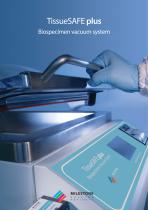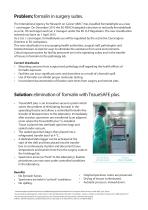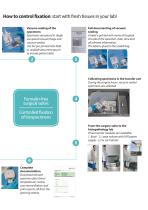 Website:
MILESTONE
Website:
MILESTONE
Catalog excerpts

TissueSAFE plus Biospecimen vacuum system
Open the catalog to page 1
Problem: formalin in surgery suites. The International Agency for Research on Cancer (IARC1) has classified formaldehyde as a class 1 carcinogen. On December 2013 the EU-REACH adopted a decision to reclassify formaldehyde as a Cat. 1B carcinogen and Cat. 2 mutagen under the EU CLP Regulation. The new classification entered into force on 1 April 2015. As a Cat. 1 carcinogen, formaldehyde use will be regulated by the restrictive Carcinogens Directive in EU workplaces. This new classification is encouraging health authorities, surgical staff, pathologists and histotechnicians to look for ways...
Open the catalog to page 2
How to eliminate formalin in surgical suites. Activation of data logger At the beginning of the shift activate (1) the data logger to continuously monitor time and temperature. Place data logger (2) in the transfer cart at 2-4 °C. 4 Place bag with specimen in the chamber and close cover (3). Formalin fixation? Molecular studies? Selected blocks are inserted in cassettes for fixation in formalin under controlled conditions (eg. FixSTATION) Your choice of fixation protocols 8 Specimen can be fixed in an ethanol based molecular fixative (eg. FineFIX). Tissue banking? Selected blocks can be...
Open the catalog to page 3
How to control fixation: start with fresh tissues in your lab! Vacuum sealing of the specimens Specimens are placed in single use special vacuum bags and vacuum sealed. Use the pre-printed note field or sealable document pouch to include patient data. Full documenting of vacuum sealing A label is printed with name of hospital ID code of the specimen, date, time and all relevant information. The label is glued to the sealed bag. Collecting specimens in the transfer cart During the surgery hours, vacuum sealed specimens are collected Formalin-free surgical suites Controlled fixation of...
Open the catalog to page 4
Optimal morphological preservation for up to 72 hours All tissues specimens. All tissue types4 have been preserved under vacuum (colon, gall bladder, spleen, kidney, thyroid, breast etc...) for up to 48-72 hours with optimal histological preservation5. Excellent H&E, HC, IHC, FISH staining properties. Over a thousand cases, using vacuum preservation, were tracked at the Molinette University Hospital in Turin, Italy. Morphological preservation and immunohistochemical reactivity were excellent and no adverse effects from the process were noted. H&E Adenocarcinoma of the colon. The specimen...
Open the catalog to page 5
Benefits for all Surgical theatre staff • No more exposure to toxic formalin fumes. • No more spilling. Pathology laboratory staff • Starting time and length of fixation controlled by the laboratory. • No toxic fumes. No handling of heavy containers. • Pre-excised colors are preserved. “Fresh-like” conditions. • Optimization of antigen retrieval protocols based on laboratory controlled fixation data. • Possibility for tissue banking. • Processing with molecular fixatives. Safety officer • Compliance with regulatory safety guidelines. • Reduction of workplace spills and associated costs and...
Open the catalog to page 6All MILESTONE catalogs and technical brochures
-
FixSTATION 1RH catalog
6 Pages
-
DecalMATE catalog
6 Pages
-
FlashFREEZE Catalog
6 Pages
Archived catalogs
-
MacroVIEW for autopsies
6 Pages
-
General Catalog
6 Pages
-
WorkSTATION catalog
6 Pages
-
UltraSAFE catalog
6 Pages
-
RoseSTATION Catalog
4 Pages
-
PRESTO PRO Catalog
6 Pages
-
PrestoCHILL Catalog
8 Pages
-
KOS
6 Pages
-
Grossing Catalog
6 Pages




























